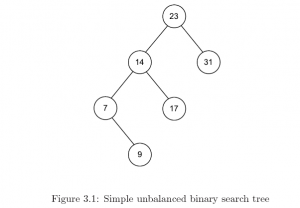

Binary search trees (BSTs) are very simple to understand. We start with a root node with value x, where the left subtree of x contains nodes with values < x
and the right subtree contains nodes whose values are ¸ x. Each node follows the same rules with respect to nodes in their left and right subtrees. BSTs are of interest because they have operations which are favourably fast: insertion, look up, and deletion can all be done in O(log n) time. It is important to note that the O(log n) times for these operations can only be attained if the BST is reasonably balanced; for a tree data structure with self balancing properties see AVL tree de¯ned in x7).


In the following examples you can assume, unless used as a parameter alias that root is a reference to the root node of the tree.
Insertion
As mentioned previously insertion is an O(log n) operation provided that the tree is moderately balanced.
1) algorithm Insert(value)
2) Pre: value has passed custom type checks for type T
3) Post: value has been placed in the correct location in the tree
4) if root = ; 5) root à node(value)
6) else
7) InsertNode(root, value)
8) end if
9) end Insert
1) algorithm InsertNode(current, value)
2) Pre: current is the node to start from
3) Post: value has been placed in the correct location in the tree
4) if value < current.Value
5) if current.Left = ; 6) current.Left à node(value)
7) else
8) InsertNode(current.Left, value)
9) end if
10) else
11) if current.Right = ; 12) current.Right à node(value)
13) else
14) InsertNode(current.Right, value)
15) end if
16) end if
17) end InsertNode
The insertion algorithm is split for a good reason. The ¯rst algorithm (non- recursive) checks a very core base case – whether or not the tree is empty. If
the tree is empty then we simply create our root node and ¯nish. In all other cases we invoke the recursive InsertNode algorithm which simply guides us to
the ¯rst appropriate place in the tree to put value. Note that at each stage we perform a binary chop: we either choose to recurse into the left subtree or the
right by comparing the new value with that of the current node. For any totally ordered type, no value can simultaneously satisfy the conditions to place it in
both subtrees.
Nggak Nyangka! Hidup Gue Berubah Total! Gue bukan siapa-siapa. Cuma anak kos biasa yang kerja serabutan buat nutup biaya hidup… Read More
What is the Main Cause of a Heart Attack? What is its Solution? A heart attack is the blockage of… Read More
In the vast economic arena, one term that often takes center stage, inciting extensive debates and discussions, is the "debt… Read More
De-Dollarization: The Changing Face of Global Finance The financial landscape is in a state of flux, with an intriguing economic… Read More
The curtains closed on a dramatic Bundesliga season with Bayern Munich standing tall once again, clinching their 11th straight title.… Read More
The Unfolding Story of Celine Dion's Health In recent news that has left fans across the globe stunned, iconic singer… Read More